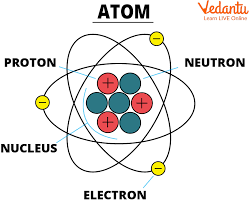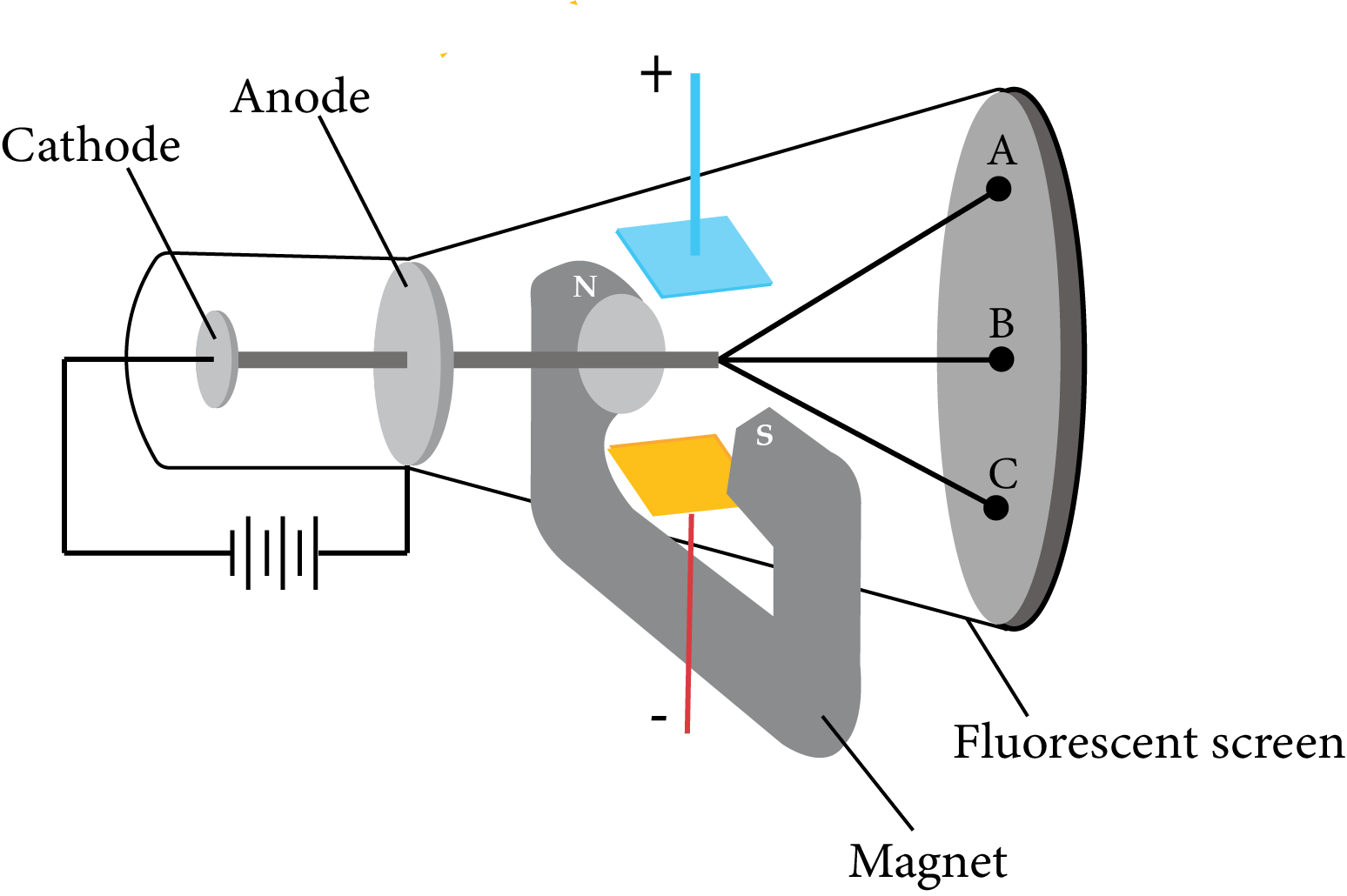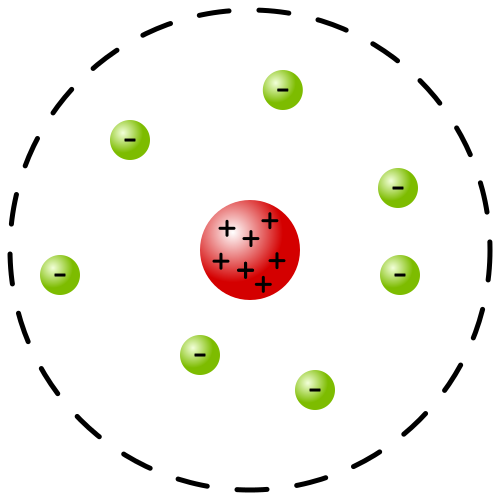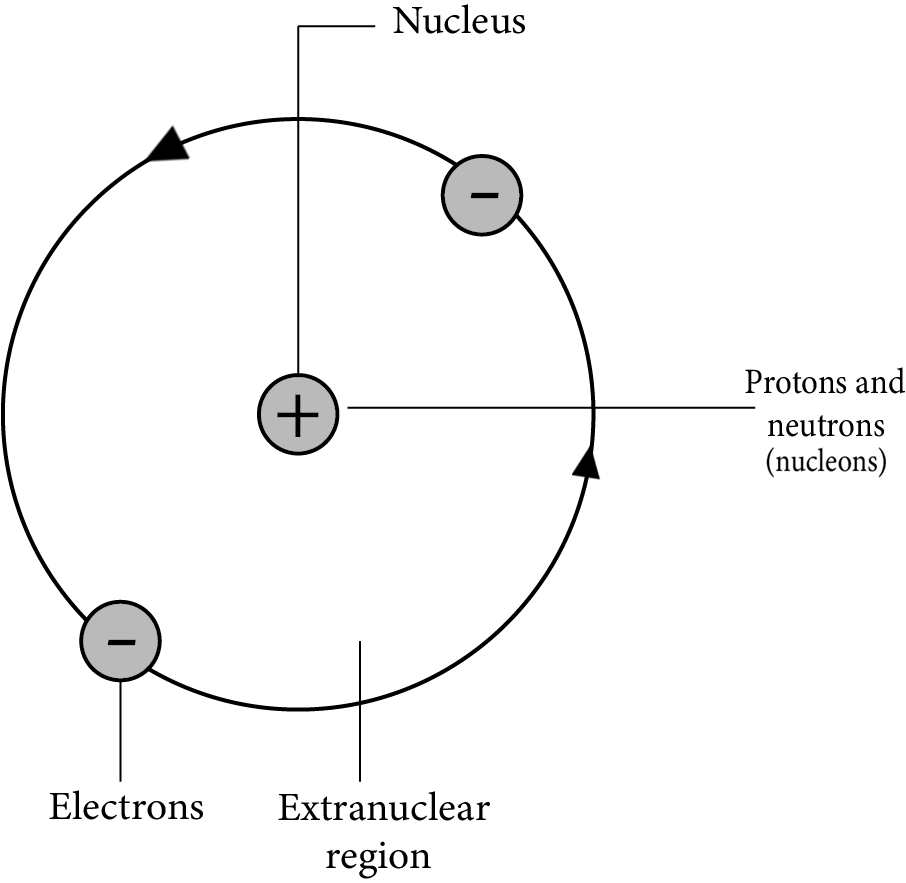




Understanding Structure of Atom: Key Models and Subatomic Particles
Understanding the atomic structure is fundamental to the study of Chemistry and Physics. The structure of an atom explains how atoms are composed and how subatomic particles interact within an atom. This knowledge helps explain the properties of elements and their behaviour in chemical reactions and forms the basis of atomic physics, quantum mechanics, and much more.
History of Atoms
The history of atoms dates back to ancient Greek and Indian thinkers like Leucippus and Democritus, who proposed the idea of indivisible particles, "atoms." Despite challenges from Aristotle's view of continuous matter, John Dalton's 1808 atomic theory marked a breakthrough, suggesting atoms were indivisible. Later, J.J. Thomson's 1897 discovery of the electron, Rutherford's 1911 nuclear model, and Bohr's 1913 refinement expanded the atomic model. The discovery of neutrons in 1932 further advanced atomic theory, incorporating electron orbitals and quantum mechanics. This evolution reflects the power of scientific inquiry in deepening our understanding of matter.
What is Atomic Structure?
The atomic structure of an element describes the arrangement of subatomic particles—protons, neutrons, and electrons—in an atom. The nucleus, consisting of protons and neutrons, is at the centre of the atom, while electrons orbit the nucleus in defined energy levels or shells.
Atomic Structure Diagram

Protons are positively charged particles found in the nucleus, and their number defines the atomic number of an element.
Neutrons, which have no charge, also reside in the nucleus and help maintain the stability of the atom.
Electrons are negatively charged particles that orbit around the nucleus. They are arranged in energy levels, with each level capable of holding a specific number of electrons.
Atoms are electrically neutral when they have an equal number of protons and electrons. However, when an atom gains or loses electrons, it becomes an ion.
The Importance of Atomic Structure
The structure of an atom is crucial for explaining the behaviour of elements in chemical reactions, atomic bonding, and the formation of molecules. It also influences the physical properties of substances, such as their boiling points, melting points, and conductivity.
Atomic Models: Understanding the Evolution of Atomic Theory
Over the centuries, various scientists have proposed models to explain the structure of atoms. These models laid the groundwork for modern atomic theory.
1. Dalton’s Atomic Theory (1803)
John Dalton proposed that:
Every matter is made up of atoms.
Atoms are indivisible and indestructible.
All atoms of an element are identical in mass and properties.
Atoms of different elements differ in size and mass.
Chemical reactions involve the rearrangement of atoms.
.png)
Dalton's atomic theory effectively explained several laws of chemical reactions, including the Law of Conservation of Mass, the Law of Constant Composition, the Law of Multiple Proportions, and the Law of Reciprocal Proportions.
Limitations of Dalton's Atomic Theory:
The theory could not account for the existence of isotopes.
It did not provide a clear explanation of the atom's internal structure.
Later discoveries of subatomic particles revealed that atoms are divisible, contradicting Dalton's idea of indivisible atoms.
2. Thomson’s Atomic Model (1897)
J.J. Thomson proposed the plum pudding model, which described the atom as a positively charged sphere with negatively charged electrons embedded within it, similar to plums in a pudding. Thomson discovered the electron through his cathode ray experiment, which demonstrated that atoms are divisible.
Cathode ray Experiment:

The experiment involved a glass tube with two openings: one for the vacuum pump and the other for gas intake. The vacuum pump maintained a partial vacuum inside the chamber, and a high-voltage power supply was connected to electrodes (cathode and anode) inside the tube.
Observations:
When the power supply was turned on, rays emerged from the cathode toward the anode, confirmed by fluorescent spots on the ZnS screen. These rays were called "Cathode Rays."
When an external electric field was applied, the cathode rays deflected towards the positive electrode. In the absence of an electric field, they travelled in a straight line.
When rotor blades were placed in the path of the cathode rays, they rotated, indicating that the rays were made up of particles with mass and energy.
From these observations, J.J. Thomson concluded that cathode rays consisted of negatively charged particles, later named "electrons." By applying electric and magnetic fields to the rays, Thomson determined the charge-to-mass ratio (e/m) of electrons, which was found to be 17588 × 10¹¹ e/bg. This allowed for the determination of the electron's charge and mass:
Charge of the electron: 1.6 × 10⁻¹⁶ C
Mass of the electron: 9.1093 × 10⁻³¹ kg
Conclusions:
Thomson’s findings led him to propose that the atom is a positively charged sphere with negatively charged electrons embedded within it, a model often referred to as the "plum pudding model." In this model, the "pudding" represents the positively charged portion, and the "plums" represent the electrons.
Limitations of Thomson’s Model:
It did not explain the atom's stability.
It failed to account for the discovery of the nucleus.
3. Rutherford’s Atomic Model (1911)
Ernest Rutherford's gold foil experiment led to the discovery of the nucleus. He concluded that:
Rutherford’s Alpha Ray Scattering Experiment
Setup:
A thin gold foil, about 1000 atoms thick, was used.
Alpha rays (helium nuclei, He²⁺) were directed at the gold foil.
A ZnS screen was placed behind the foil to observe the scattering of the rays.

Observations:
Most of the alpha rays passed straight through the gold foil, creating bright spots on the ZnS screen.
A small number of rays were deflected after hitting the gold foil.
Around 1 in 1000 rays were deflected at an angle of 180° (retraced their path) after interacting with the gold foil.
Conclusions:
Since most rays passed through undisturbed, Rutherford concluded that most of the atom is empty space.
The few deflected rays indicated a repulsion between the positive charge of the alpha particles and a similarly charged positive region within the atom.
The rare but strong deflections (180°) suggested the presence of a strong positive charge at the atom's centre, which Rutherford identified as the nucleus.
Rutherford proposed that the nucleus contains most of the atom's mass and charge, and electrons revolve around it in circular orbits, much like how planets orbit the sun.
Rutherford’s Model of the Atom
The nucleus is located at the centre of the atom, containing most of its mass and positive charge.
The atom’s structure is spherical, with electrons orbiting the nucleus in defined circular paths.

Limitations of Rutherford’s Model:
If electrons orbit the nucleus, they would lose energy due to the strong attraction between them and the nucleus. As they lose energy, they would spiral inward and eventually collapse into the nucleus, causing instability.
Rutherford's model predicted that if electrons continuously orbited the nucleus, the resulting spectrum would be a continuous spectrum. However, experimental observations showed that atoms emit a line spectrum instead, highlighting a flaw in his theory.
4. Bohr’s Atomic Model (1913)
Niels Bohr built upon Rutherford's model and introduced the concept of quantised energy levels. According to Bohr:
Electrons orbit the nucleus in fixed orbits without radiating energy.
Electrons can jump between orbits by absorbing or emitting specific amounts of energy (quantum of energy).
The energy of the orbits is quantised.

Bohr's model explained the stability of the atom and the line spectra of elements but was limited to simple atoms like hydrogen.
Subatomic Particles: Understanding Protons, Neutrons, and Electrons
Protons
Charge: Positive (+1)
The charge of a proton is 1e, which corresponds to approximately $1.602\times 10^{-19} \, \text{kg}$
Mass: Approximately $1.672\times 10^{-24} \, \text{kg}$
Location: Nucleus
Role: The number of protons determines the atomic number and identity of an element.
Neutrons
Charge: Neutral (0)
Mass: Approximately $1.675 \times 10^{-24} \, \text{kg}$
Location: Nucleus
Role: Neutrons help to stabilise the nucleus and vary in number among isotopes of an element.
Electrons
Charge: The charge of an electron is -1e, which approximates to -1.602 × 1019
Mass: $\times 9.1^{-31} \, \text{kg}$(much smaller than protons and neutrons)
Location: Orbit around the nucleus in shells
Role: Electrons are responsible for chemical bonding and the element’s chemical properties.
Isotopes: Atomic Variants with Different Neutron Numbers
Isotopes are atoms of the same element that have the same number of protons but different numbers of neutrons. This results in different mass numbers. For example:
Hydrogen has three isotopes: protium (1 proton, 0 neutrons), deuterium (1 proton, 1 neutron), and tritium (1 proton, 2 neutrons).
Carbon has isotopes like Carbon-12 (6 protons, 6 neutrons) and Carbon-14 (6 protons, 8 neutrons), the latter used in radiocarbon dating.
Isotopes of an element behave chemically the same but may have different stabilities and half-lives.
Quantum Numbers: Describing Electron Behaviour
Principal Quantum Number (n): Describes the energy level or shell where the electron resides.
Azimuthal Quantum Number (l): Indicates the orbital shape (s, p, d, f).
Magnetic Quantum Number (m): Describes the orientation of the orbital in space.
Spin Quantum Number (s): Specifies the direction of electron spin (clockwise or anticlockwise).
These quantum numbers explain the arrangement of electrons in atoms and are essential for understanding electron configurations.
Bohr’s Model and Quantum Mechanics
Bohr's Atomic Theory
In 1915, Niels Bohr proposed a model for the atom that remains one of the most widely used to describe atomic structure. His theory was based on Planck’s theory of quantisation, which introduced the concept of energy levels for electrons.
Postulates of Bohr's Atomic Model:
Electrons are placed in specific orbits, known as "stationary orbits," around the nucleus.
These orbits have defined energy levels, which are represented by quantum numbers.
Electrons can move to higher energy levels by absorbing energy and to lower levels by emitting energy.
As long as an electron remains in a specific orbit, it does not absorb or emit energy.
Electrons orbit the nucleus in these stationary orbits only, and the energy associated with these orbits is quantised.
Limitations of Bohr's Atomic Theory:
Bohr's model works primarily for single-electron species like hydrogen (H), helium ion (He⁺), lithium-ion (Li²⁺), and beryllium ion (Be³⁺).
When hydrogen’s emission spectrum was observed more precisely, it showed that each spectral line consisted of smaller, discrete lines.
Bohr’s theory could not explain phenomena like the Stark effect and Zeeman effect, which involve the deflection of electrons in electric and magnetic fields, respectively.
Heisenberg's uncertainty principle challenged Bohr’s model. It states that conjugate physical quantities, like position and momentum, cannot be measured simultaneously with perfect accuracy. There will always be some level of uncertainty in measurements.
The Stark and Zeeman Effects:
The Stark effect refers to the deflection of electron paths under an electric field.
The Zeeman effect refers to the deflection of electron paths under a magnetic field.
Dual Nature of Matter:
Electrons were traditionally thought of as particles, but evidence, such as the photoelectric effect, suggests that electrons also exhibit wave properties. Thomas Young's double-slit experiment helped demonstrate this.
Louis de Broglie concluded that, since nature is symmetrical, all matter—including light—should also exhibit wave characteristics.
Quantum Numbers:
Principal Quantum Number (n): Indicates the energy level or shell number of an electron.
Azimuthal Quantum Number (l): Represents the orbital shape or sub-orbit of an electron.
Magnetic Quantum Number: Describes the number of possible energy states within a given orbit.
Spin Quantum Number (s): Indicates the direction of the electron’s spin, with values of -½ for anticlockwise spin and +½ for clockwise spin.
Electronic Configuration: Arranging Electrons in Atoms
According to the Aufbau principle, electrons fill the lowest energy orbitals first. This process is governed by:
Pauli’s Exclusion Principle: No two electrons can have the same set of quantum numbers.
Hund’s Rule: Electrons fill degenerate orbitals singly before pairing up.
The electronic configuration of elements explains their chemical behaviour and bonding.
Conclusion: Understanding Atomic Structure
The study of atomic structure provides valuable insights into the chemical and physical properties of elements. From Dalton’s indivisible atoms to the Bohr model and modern quantum mechanics, the understanding of atomic structure has evolved significantly. The concept of isotopes, the role of subatomic particles, and the quantum numbers that describe electron positions help us explain chemical reactions, bonding, and the properties of matter.
Atomic Structure - Electrons, Protons, Neutrons and Atomic Models

 Share
ShareFAQs on Atomic Structure - Electrons, Protons, Neutrons and Atomic Models
1. What is atomic structure?
Atomic structure refers to the arrangement of subatomic particles—protons, neutrons, and electrons—within an atom. The nucleus contains protons and neutrons, while electrons orbit the nucleus in defined energy levels.
2. What are the different models of the atom?
The main atomic models include:
Dalton’s Model: Atoms are indivisible.
Thomson’s Model: The atom is a positively charged sphere with electrons embedded in it (plum pudding model).
Rutherford’s Model: The atom has a central nucleus with electrons orbiting around it.
Bohr’s Model: Electrons move in fixed orbits around the nucleus, with quantized energy levels.
3. What are subatomic particles?
Subatomic particles include:
Protons: Positively charged particles in the nucleus.
Neutrons: Neutral particles in the nucleus.
Electrons: Negatively charged particles orbiting the nucleus.
4. How do electrons orbit the nucleus?
According to Bohr's model, electrons orbit the nucleus in defined, quantized orbits (energy levels). Each orbit corresponds to a specific energy level, and electrons can move between these levels by absorbing or emitting energy.
5. What are isotopes?
Isotopes are atoms of the same element that have the same number of protons but different numbers of neutrons. This results in different mass numbers for the isotopes of an element, like Carbon-12 and Carbon-14.
6. What are quantum numbers?
Quantum numbers describe the position and energy of an electron in an atom:
Principal Quantum Number (n): The energy level or shell of the electron.
Azimuthal Quantum Number (l): The shape of the orbital (s, p, d, f).
Magnetic Quantum Number (m): The orientation of the orbital.
Spin Quantum Number (s): The direction of the electron's spin (clockwise or anticlockwise).
7. Why is atomic structure important?
Understanding atomic structure is crucial for explaining how atoms bond, their chemical properties, and how elements interact. It also helps in understanding the physical properties of substances, such as melting and boiling points.
8. What is Bohr's atomic model?
Bohr's atomic model suggests that electrons orbit the nucleus in fixed paths or orbits without radiating energy. These orbits have quantized energy levels, and electrons can jump between levels by absorbing or emitting energy.
9. What is the significance of Rutherford’s gold foil experiment?
Rutherford's gold foil experiment led to the discovery of the nucleus. It showed that most of the atom is space and that the atom has a small, dense, positively charged nucleus at its center.
10. What are the limitations of Bohr’s atomic model?
Bohr’s model works well for hydrogen but fails for atoms with more than one electron. It cannot explain the Stark and Zeeman effects and doesn't account for the wave nature of electrons.
11. Where Can I Get the Complete Structure Of Atom Notes?
You can access complete Structure of Atom notes on Vedantu by following these steps:
Visit Vedantu's Website: Go to Vedantu and navigate to the JEE, CBSE, or Class 9/11 sections.
Search for the Topic: Use the search bar and enter "Structure of Atom" to find notes for different levels, including Class 9 and Class 11.




















 Watch Video
Watch Video


